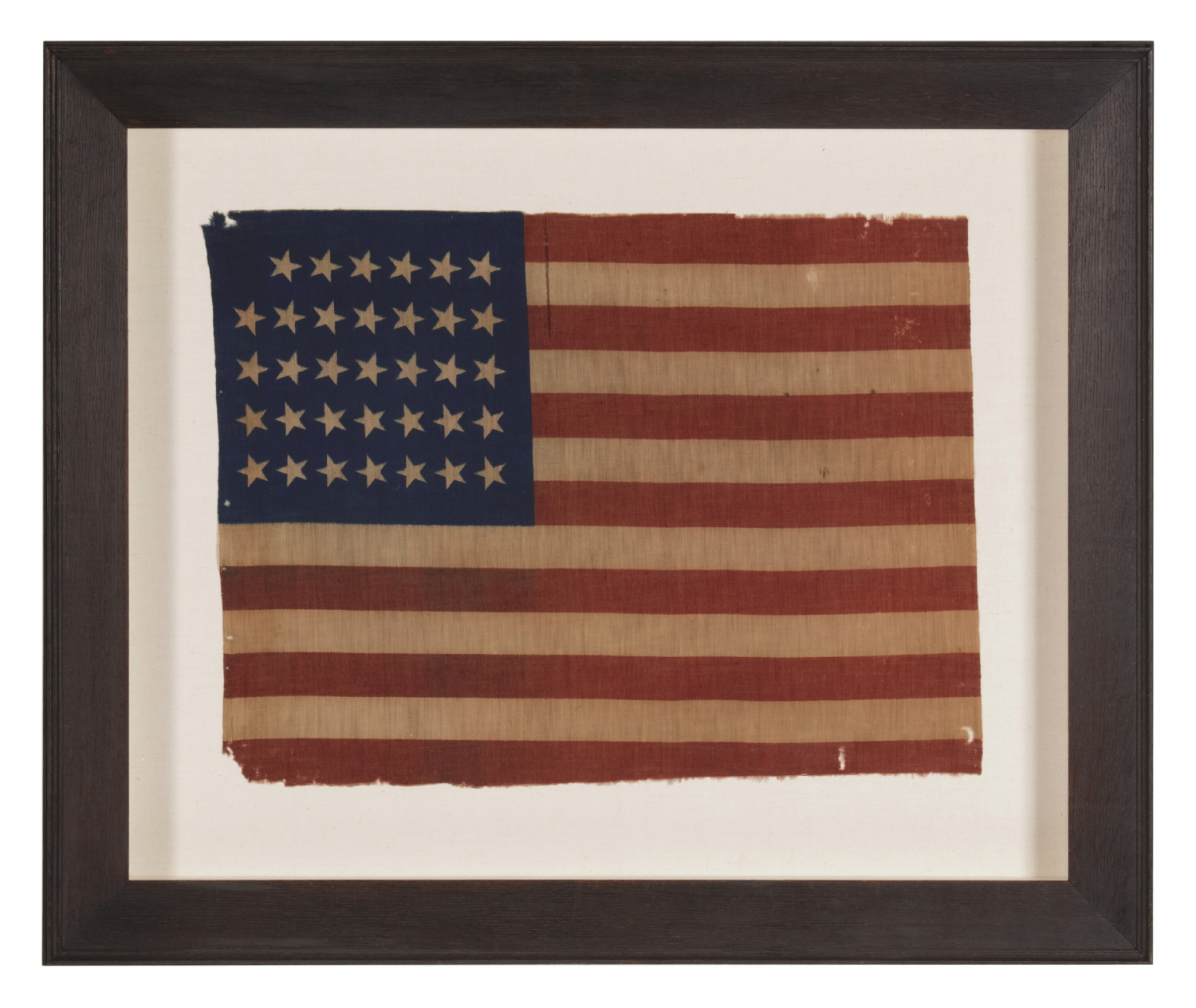
| |
34 STARS, CIVIL WAR PERIOD, PRINTED ON A WOOL BLENDED FABRIC, RARE NOTCHED DESIGN WITH TILTED STARS, POSSIBLY A UNION ARMY CAMP COLORS |
|
| Available: |
Sold |
| Frame Size (H x L): |
27" x 32.5" |
| Flag Size (H x L): |
17" x 22.25" |
|
| Description....: |
|
34 star American national flag, printed on a wool and cotton blend. The star configuration, which leaves a single star missing from the top row, is very unusual for this time period. Called a “notched” design, the blank space leaves little doubt that the maker of the flag assumed that West Virginia might soon break free from Virginia (which occurred in 1863), or that another Western Territory would soon acquire statehood.
The first 3 rows of stars are tilted to the 1:00 position, while the last two rows tilt to 11:00. This is yet another unusual feature that I have only seen on this particular style of 34 star flag, of which a handful of examples are known to exist.
It is likely that this variety was produced as a military camp colors, used to mark Union Army encampments. The size and proportions are very close to that of other identified flags used for that purpose. Wool content made outdoor use flags more durable than those produced of silk or cotton. Wool sheds water and was the best storm-worthy fabric available for flag-making in the 19th century.
The difficulty with using wool bunting (the fabric most often employed in the manufacture of flags for long term outdoor use) is that wool is difficult to print, even today. Printed wool flags were first produced by clamp-dyeing in the 1840's, through use of a special apparatus, but this was patented at the time that this 34 star flag was made. The inclusion of cotton in a blended wool fabric may have made it possible to block or roller print flags, which would have been more expedient, while at the same time avoiding the violation of patent laws. The longevity of the fabric would have perhaps been shorter, but it would have been an improvement over cotton or cotton and flax blends, which were used in most printed flags made for parades, rallies and general short term patriotic purposes.
Kansas was admitted into the Union as the 34th state on January 29th, 1861, about 2 ½ months before the Confederate assault on Fort Sumter that marked the beginning of the Civil War. The 34th star was officially added on July 4th of that year, but most flag makers would have added a 34th star with the addition of Kansas in January. The star count remained official until July 4th, 1863, and 34 star flags would have generally been produced until the addition of West Virginia in June of that year.
Mounting: The frame is a deep and dramatic shadowbox, constructed from a ca 1880-1920 era, Arts & Crafts style, acid-washed oak molding, to which additional, period, acid-washed oak, salvaged from another period frame, was added to create the shadowbox itself. The flags has been hand-stitched to 100% hemp fabric. The glazing is U.V. protective acrylic.
Condition: There is a vertical tear in the striped field, extending from the 1st to the 3rd stripe, adjacent to the canton. This was stabilized during the mounting process. There is an overall oxidation of the white stripes to a golden tan and there are moderate losses in all four corners, accompanied by fraying with associated loss along the top and bottom edges. There are more minor losses elsewhere throughout, the most significant of which are located in the 2nd, 3rd, 12th and 13th stripes, near the fly end. There are tack holes along the hoist end where the flag was once affixed to its original staff. Many of my clients prefer early flags to show their age and history of use. Further, this is a very scarce and desirable, war-period example. |
|
|
|
| Collector Level: |
Advanced Collectors and the Person with Everything |
|
| Flag Type: |
Parade flag |
|
| Star Count: |
34 |
|
| Earliest Date of Origin: |
1861 |
|
| Latest Date of Origin: |
1864 |
|
| State/Affiliation: |
Kansas |
|
| War Association: |
1861-1865 Civil War |
|
| Price: |
SOLD |
|
| |
Views: 1014 |
|
|
|

